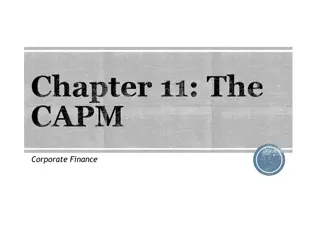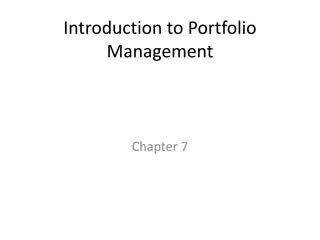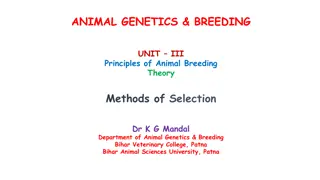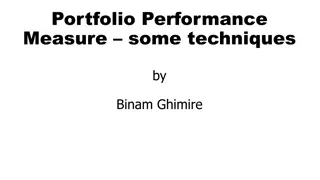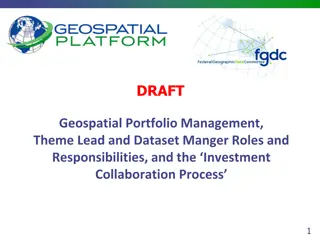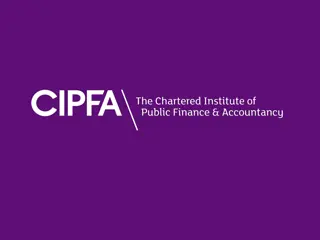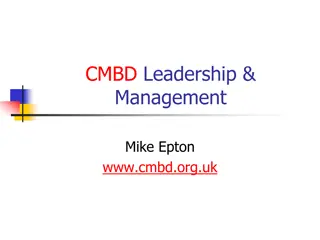
Leadership and Project Selection Models in Project Management
Explore the importance of project selection models and leadership in project management. Learn about financial models, project portfolio management, and the traits of effective project leaders. Dive into the methods of project screening and selection to maximize project success.
Download Presentation

Please find below an Image/Link to download the presentation.
The content on the website is provided AS IS for your information and personal use only. It may not be sold, licensed, or shared on other websites without obtaining consent from the author. If you encounter any issues during the download, it is possible that the publisher has removed the file from their server.
You are allowed to download the files provided on this website for personal or commercial use, subject to the condition that they are used lawfully. All files are the property of their respective owners.
The content on the website is provided AS IS for your information and personal use only. It may not be sold, licensed, or shared on other websites without obtaining consent from the author.
E N D
Presentation Transcript
Project Management Topic 5 1. Project Selection and Portfolio Management 2. Leadership And The Project Manager
LEARNING OUTCOMES After completing this chapter, you should be able to: Explain six criteria for a useful project selection/ screening model. Learn how to use financial concepts, such as the efficient frontier and risk/return models. Identify the elements in the project portfolio selection process and discuss how they work in a logical sequence to maximize a portfolio. Understand how project management is a leader-intensive profession. Distinguish between the role of a manager and the characteristics of a leader. Understand the key behaviors in which project leaders engage to support their
Outline 1. Project Selection 2. Approaches to Project Screening and Selection 3. Financial Models 4. Project Portfolio Management 5. Leadership vs manager 6. How the Project Manager Leads 7. Traits of Effective Project Leaders 8. Project Champions 9. The New Project Leadership 10. Project Management Professionalism
PROJECT SELECTION PROJECT SELECTION
Screening Models Screening models help managers pick winners from a pool of projects. Cost Ease of use Realism Flexibility effective- ness Capability Comparability
APPROACHES TO PROJECT SCREENING AND APPROACHES TO PROJECT SCREENING AND SELECTION SELECTION
Method of Selection Checklist Model Simplified Scoring Models The Analytical Hierarchy Process Profile Models
FINANCIAL MODELS FINANCIAL MODELS
Net Present Value Projects the change in the firm s stock value if a project is undertaken. Higher NPV values are better
Discounted Payback Period The discounted payback period is a measure of how long it takes until the cumulated discounted net cash flows offset the initial investment in an asset or a project. Formula : DPP = y + abs(n) / p, where y = the period preceding the period in which the cumulative cash flow turns positive, p = discounted value of the cash flow of the period in which the cumulative cash flow is => 0, abs(n) = absolute value of the cumulative discounted cash flow in period y.
Internal Rate of Return A project must meet a minimum rate of return before it is worthy of consideration. where ACFt= annual after-tax cash flow for time period t IO = initial cash outlay n = project s expected life IRR = project s internal rate of return Higher IRR values are better!
example Suppose that a project required an initial cash investment of $5,000 and was expected to generate inflows of $2,500, $2,000, and $2,000 for the next three years. Further, assume that our company s required rate of return for new projects is 10%. The question is, is this project worth funding?
example Cash investment = $5,000 Year 1 inflow = $2,500 Year 2 inflow = $2,000 Year 3 inflow = $2,000 Required rate of return = 10% Step One: Try 12%. Decision: Present value difference at 12% is 250.50, which is too high. Try a higher discount rate.
example Step Two: Try 15%. Decision: Present value difference at 15% is $3, which suggests that 15% is a close approximation of the IRR.
PROJECT PORTFOLIO PROJECT PORTFOLIO MANAGEMENT MANAGEMENT
Project Portfolio Management The systematic process of selecting, supporting, and managing the firm s collection of projects. Project portfolio management should have four goals: 1. maximizing the value of the portfolio the goal is to ensure that the total worth of projects in the pipeline yields maximum value to the company, 2. achieving the right balance of projects in the portfolio there should be a balance between high-risk and low-risk, short-term and long-term, genuine new products and product improvement projects, 3. achieving a strategically-aligned portfolio leading companies have a clear product innovation strategy that directs their R&D project investments, 4. resource balancing having the right number of projects in the portfolio is critical
Objectives And Initiatives Portfolio management, therefore, entails decision making, prioritization, review, realignment, and reprioritization of a firm s projects
Developing A Proactive Portfolio Three factors determined that successfully managed project portfolios : Flexible structure and freedom of communication Low-cost environmental scanning Time-paced transition
LEADERS VERSUS MANAGERS LEADERS VERSUS MANAGERS
Leadership Leadership is a difficult concept to examine because we all have our own definition of leadership, our own examples of leaders in action, and our own beliefs about what makes leaders work. Project management has been viewed as one of the most leader-intensive undertakings within an organization.
Partnership Idea Four things are necessary to promote the partnership idea between the project manager and the team: Exchange of purpose A right to say no Joint accountability Absolute honesty
HOW THE PROJECT MANAGER LEADS HOW THE PROJECT MANAGER LEADS
How the Project Manager Acquiring Project Resources Motivating and Building Teams Having a Vision and Fighting Fires Communicating
TRAITS OF EFFECTIVE PROJECT LEADERS TRAITS OF EFFECTIVE PROJECT LEADERS
Five Characteristics Closely Associated Five characteristics closely associated with effective project team leaders: Credibility Creative problem-solver Tolerance for ambiguity Flexible management style Effective communication skills
PROJECT CHAMPIONS PROJECT CHAMPIONS
How To Make A Champion Identify And Encourage The Emergence Of Champions Encourage And Reward Risk Takers Remember That Champions Are Connected Emotionally To Their Projects Don t Tie Champions Too Tightly To Traditional Project Management DutieS
THE NEW PROJECT LEADERSHIP THE NEW PROJECT LEADERSHIP
Four competencies Four competencies that determine our success as project leaders The new leader understands and practices the power of appreciation. These project leaders are connoisseurs of talent, more curators than creators The new leader keeps reminding people of what s important The new leader generates and sustains trust The new leader and the led are intimate allies
PROJECT MANAGEMENT PROFESSIONALISM PROJECT MANAGEMENT PROFESSIONALISM
Professionalism Growing professionalism of the project management discipline First, for more and more organizations, project work is becoming the standard Second, there is a critical need to upgrade the skills of those doing project work Third, project management professionalism recognizes the need to create a clear career path for those who serve as project managers and support personnel
Reference Jeffrey Pinto, 2021, Project Management Achieving Competitive Advantage, Fifth Edition, Pearson Education Limited, United Kingdom, ISBN 978-1-292-26914-6. Chapter 3 and 4






